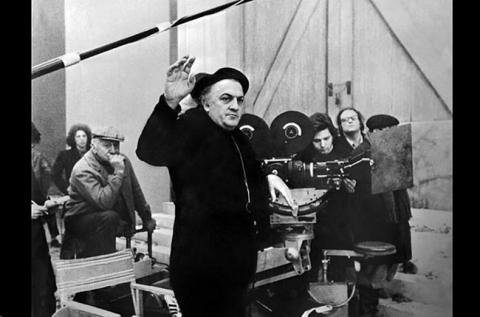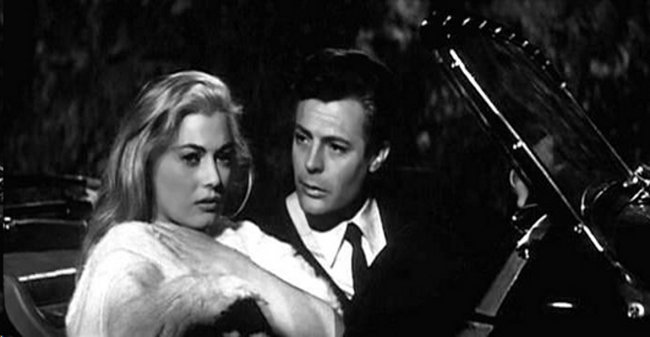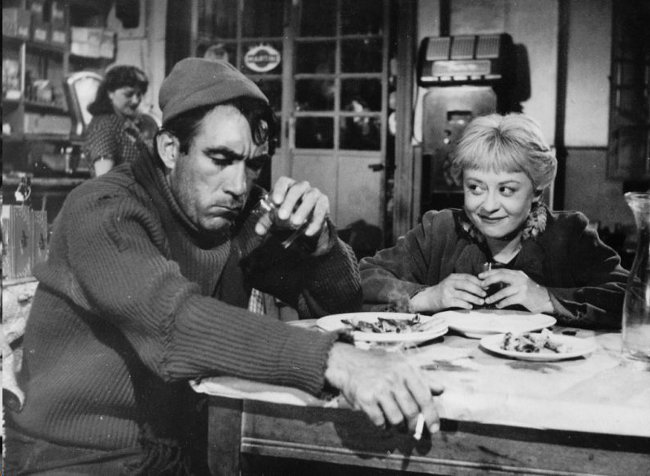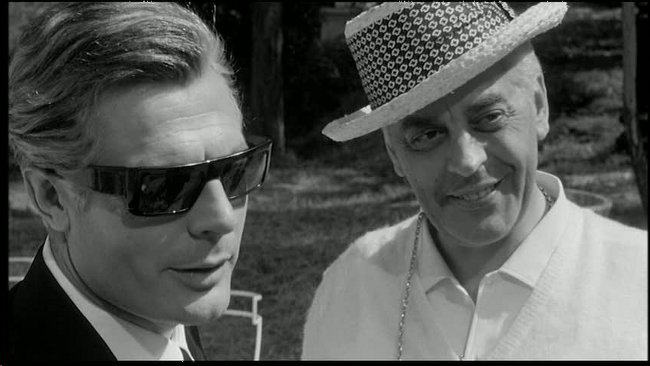Remembering Fellini’s Best Films

Halloween is a day of masks, of costumes and façades, a festival of gargoyles and monsters, a day when fantasy distinctly blends with reality. For filmmaker Federico Fellini, every day was Halloween – masks that hide our true emotions, a circus, a magic performance, a sideshow, the lines of illusion and reality constantly blurred. His films employed the talents of beautiful actors like Marcello Mastroianni and Anita Ekberg, while also exploiting the looks of the strange and the grotesque. It was fitting for the acclaimed director Federico Fellini to have made his final departure from this world 20 years ago on October 31. He was followed only months later by his wife of 50 years, and the star of many of his films, Giulietta Masina.
Fortunately for us, the work of the artist lives on long after his passing. And though Fellini may have exited this world’s stage – a stage much larger and more unpredictable than his beloved Cinecittà Teatro 5 (later renamed in his honor) –20 years ago, his legacy continues. Known as the director who (along with Michelangelo Antonioni) spearheaded Italian cinema’s divergence from neorealism, Fellini – fostered under the tutelage of Roberto Rossellini – was a director of great import not only to Italian cinema but to international film. Sometimes referred to as the Maestro, or a puppet-master with a desire for absolute control, it was this characteristic that made Fellini a difficult director for many actors to work with (as Donald Sutherland explains in Damian Pettigrew’s 2002 documentary, Fellini: I’m a Born Liar) but that also made him shine, contributing to his “Felliniesque” style. Fellini also has a poetic sensibility that permeates his work and has had an immeasurable impact on the works of directors like Woody Allen and Martin Scorsese. His films continue to make lasting impressions on audiences and filmmakers around the world.
While it is no easy task to compile a list of the best works of any artist, let alone one of the most influential and groundbreaking directors in cinematic history, and while any attempt to make a “best of” list is highly subjective, this is a challenge I am willing to take. Of course Fellini is a visual director and the best way to experience the magic is to see the films themselves.
8 ½ (1963): “Everything and nothing in my work is autobiographical,” writes Fellini in the essay “Rimini, my hometown.” While autobiographical fragments can be found in other works (especially Amarcord), in 8 ½ the viewer feels that Fellini exposes his soul to the audience for the first time. The film stars Marcello Mastroianni as Guido Anselmi (representing the Maestro himself), a frequent Fellini collaborator, as a philandering director with mental block that prevents him from finishing the film he is working on. Going a step beyond the daring leap Fellini would take with La Dolce Vita, this film toys with reality and fantasy, dreams and desires, with searing flashback imagery that is not easily forgotten (La Saraghina dancing the Rumba, the children chanting Asa Nisi Masa after being tucked into their beds and, of course, the famous harem scene). A disciple of Jungian psychology, the director here dives deep into the dream world (“Nothing is more honest than a dream” the auteur explains), while simultaneously taking issue with ideology (the scenes with Daumier, the French intellectual) and the crude complexities of the modern world. The film also stars Anouk Aimèe (who appeared in Fellini’s La Dolce Vita) as Guido’s troubled wife Louisa and is set to the background of one of Nino Rota’s most memorable scores. The images from this film, like those in our own recurring dreams, are not easily forgotten. And the film’s ending is as hopeful and magical as anything in Fellini’s catalogue, with Guido’s acceptance of himself and the mélange of actions, people, dreams and fantasies that make him who he is: embracing himself “as I am . . . not as I would like to be.” It is a carnival, a circus, an illusion, the film that won him his third (of four) Best Foreign Language Film Academy Awards and, most importantly, the director’s chef-d'oeuvre

La Dolce Vita (1960) If La Strada was the beginning of Fellini’s break with neorealism, with La Dolce Vita he cut loose any remaining strings that kept him tethered to the filmmaking conventions of his past. Though sometimes viewed as a sequel to I Vitelloni, this film is really so much more. As Fellini explains, “The only connection is the autobiographical vein that is in all my work.” The opening sequence really sets the stage for the whole piece, dealing with such themes as the juxtaposition of the sacred and the profane and the sense of alienation in modern culture. This sequence begins with a helicopter carrying a statue of Christ to the Vatican, followed by another helicopter occupied by journalist Marcello Rubini (Mastroianni). The Christ statue is flown over the Roman landscape, past images of the sacred past and profane present. At one point, the statue soars over the heads of a group of sunbathing beauties, with one yelling out: “Look! It’s Jesus!” This is shortly followed with a failed attempt at communication, as Marcello tries to obtain the phone number of one of the sunbathers; communication breakdown would be revisited in several crucial scenes throughout the film, culminating with a drunken Marcello on his knees at the sea (the same setting where we find Zampanò at the end of La Strada – the sea representing to Fellini the unknown and the unconquerable), unable to understand the message sent to him by the “Umbrian angel” he met earlier in the film.
Add to this the unforgettable scene with Anita Ekberg and Marcello Mastroianni splashing in the Trevi Fountain at night, the tragic backstory of the intellectual Steiner (the man Marcello admires, whose seemingly flawless life is anything but perfect), the media frenzy of journalists trying to cover the story of children who claim to see visions of the Madonna, the tensions between Marcello and his father and the eerie castle sequence with Nico and one has all of the visual elements of an art house masterpiece. Unlike Fellini’s earlier films, the message of hope is diminished, though not entirely gone; Marcello seems lost in a sea of confusion. But as Fellini explains, “[The title] simply meant to say that in spite of everything life had its profound undeniable sweetness.” And in that sense, the central message may not be so overtly hopeful, but not really all that different from his earlier films. La Dolce Vita was both a critical and commercial success, deservedly winning the Palm d’Or at the 1960 Cannes Film Festival, it made the word paparazzi part of our lexicon, and for Fellini it marked a pivotal point in his filmmaking career.
La Strada (1954) Fellini has referred to La Strada as “really the complete catalogue of my mythical world.” Sometimes seen as part of a trilogy – with Il Bidone and Nights of Cabiria – the work deals with themes of loneliness and hope. And no actress captures the depth of these emotions so well as Giulietta Masina, playing a simpleton who, despite so many setbacks, still manages to find beauty and goodness in the world (the Umbrian angel of this film, or the station boy from I Vitelloni). Many critics saw this film as Fellini’s first break with neorealism. Fellini employed the talents of Hollywood stars like Richard Basehart (as the Fool) and Anthony Quinn (as the gruff Zampanò) and many Italian Marxists criticized what they saw as a religious element in the film: Zampanò’s redemption and the story of the pebble, which the Fool tells to Gelsomina to help her realize that she has a purpose in life, even if she does look like “an artichoke.” The film won an Academy Award for Best Foreign Language Film in 1956, and though all of the actors deliver superb performances, it is really Masina who steals the show with a comedic brilliance comparable to Charlie Chaplin. The film’s main theme is also one of Nino Rota’s best compositions, a hauntingly beautiful piece that Masina requested played at her funeral. In short, the film is a poetic masterpiece that was, like so many of Fellini’s works, in his own words, “Born not from logic but from love.”

Amarcord (1973) The title of this work is often translated as “I remember” in the dialect of Rimini, the Italian town from where Fellini hails, though Fellini has denied this. It is evident from his essay, “Rimini, My Hometown,” that much of this film is autobiographical, at least as much so as 8 ½ and Juliet of the Spirits. But it is also invention (for Fellini the two are inseparable): the film’s characters (much like those in Fellini’s Roma) are caricatures of figures from his boyhood, grotesque cartoon versions of the people whose impression on the director was indelible – from Titta (Fellini’s boyhood friend) to Gradisca the owner of the beauty store (a prostitute from his hometown). And the film’s setting is an obvious representation of Fellini’s Rimini, where “there is a sharp division between the seasons. . . . [A] substantial change, not just a meteorological one, as in other cities.” Just as the characters are caricatures, so too is the landscape – particularly the radical change of seasons and the glaringly fake sea of plastic. The film deals with politics, religion (Fellini explains, “Religion,” an important element in this and his other films, “always had something terrifying about it”) and sexual repression (and its effects on the psyche). Amarcord won the Academy Award for Best Foreign Language Film, Fellini’s fourth and final win in this category and is typically considered both his last commercial success and his last great film.

Nights of Cabiria (1957) “Giulietta [Masina] is not just the main actress in a number of my films, but in a very subtle way their inspiration as well,” says Fellini, adding, “[S]he herself is the theme.” This is true not only for Nights of Cabiria, but, undoubtedly, for La Strada and perhaps (less significantly) even Juliet of the Spirits. This film won Fellini his second Academy Award for Best Foreign Language Film, and it won Masina a Best Actress Award at Cannes. Not dissimilar from her character in La Strada, Gelsomina, here Masina plays the lonely yet proud and hopeful (against all odds) prostitute Cabiria, reprising a role that she originally played in Fellini’s first solo directorial effort, The White Sheik. This is probably, along with The White Sheik, one of Fellini’s most hilarious films, owed to Masina’s comedic talents. Particularly memorable are the scene where she is shaking loose to the mambo while everyone around her dances somberly and when she rides off with actor Alberto Lazzari in his convertible, yelling to a fellow prostitute: “Hey, fancy pants! . . . Look at me! Look who I'm with! Up yours!” As the movie progresses it is easy to sympathize with Cabiria. Like Chaplin’s Tramp, she never emerges victorious, yet she refuses to give up. “In spite of everything,” writes Fellini, “Cabiria still carries in her heart a touch of grace.” And in the end, he adds: “Her fate is in the hands of each one of us.”
Juliet of the Spirits (1965) Fellini once remarked that he is always making the same film. Nowhere in his oeuvre does this seem more evident than when comparing Juliet of the Spirits to 8 ½. Here the Maestro takes the fantasy elements and flashbacks from his earlier film, the circus components, the masks, the continued exploration of the sources of his creativity, the questions of infidelity and its effect on the marital relationship and rearranges the story from the female perspective, that of Giulietta Masina as “Giulietta,” the “good little housewife” who arranges pepper wreaths while her husband is having an affair.
Because the story has really been told before it doesn’t warrant a higher spot on this list, but it is the depth brought to the character by the multi-faceted Masina that makes the film shine. She brings to the film her special comic touch (upon discovering that her husband’s mistress is beautiful, Giulietta asks the woman who divulges this information, “Also a slut, right? . . . It’s becoming a sort of compliment”), as well as her characteristic pathos. What also sets this surreal film apart is that it was Fellini’s first full-length color film. The phantasmagoric flick won a Best Foreign Film Golden Globe Award in 1966.

I Vitelloni (1953) Following the relative failure of Fellini’s first solo directorial effort, The White Sheik (1952), this was the film that would redeem him. The critically acclaimed work won the Silver Lion at the Venice Film Festival in 1953 and also won an Academy Award for Best Writing. Here Fellini employed many of the same talent that he used in The White Sheik and, not unlike La Dolce Vita, many of the characters bore the names of the actors who played them: Alberto Sordi as “Alberto,” Leopoldo Trieste as “Leopoldo,” and Fellini’s own brother, Riccardo (a spitting image of the Maestro), as “Riccardo.” Like the White Sheik before it, and like Variety Lights (co-directed with Alberto Lattuada), I Vitelloni explores daydreams versus mundane reality and here Fellini really probes the psyches and souls of his characters. In I Vitelloni, while many of the characters dream of a successful life outside of the Italian provinces it is Moraldo Rubini (Franco Interlenghi) who ultimately flees this life, fed up with his peers’ immaturity and yet unwilling to accept the drab duties of his parents’ generation as a desirable alternative. What happens ultimately to Moraldo we don’t know; his destiny, like that of Cabiria or Marcello or Titta, or any other Fellini character, is left to the imaginations of the audience.
Intervista (1987) Winner of the First Prize at the Moscow Film Festival, this is a piece that Fellini explains “unfolds as you watch it.” This film really contains four works in one: Intervista itself, a film masquerading as a documentary; the documentary aspect of the film, as a cast of young Japanese documentary filmmakers follow Fellini (as himself) around Cinecittà; Fellini’s attempt to make a picture based on Franz Kafka’s Amerika; and, finally, the backstory about Fellini’s beginnings as a young journalist. It is a work of magic, and not unlike 1983’s And the Ship Sails On (when the crew is shown to the audience in the process of making the film), the director allows viewers a backstage glimpse into how the magic is made.
As members of an audience, we know that what we see on the big screen is an illusion, though we often forget and get lost in the story and the elements that make it seem “real.” But, at least since 8 ½, Fellini has reminded his audiences as they watched the film that what they were seeing was, in fact, an illusion. In Amarcord, Casanova and And the Ship Sails On, he makes it abundantly clear that the film is a conjuring trick, with obviously fake sets, including his seas made of plastic. But – even knowing that it is fake – we are still dazzled by the illusions. In Intervista Fellini takes this all a step further. The most magical (and emotional) moment of all is when Marcello Mastroianni reunites with Anita Ekberg (both much aged, as almost three decades have elapsed since La Dolce Vita) to re-enact their famous Trevi Fountain scene. The film explores the role of Fellini as puppet-master and ringleader, examines the process by which he casts his eccentric collection of actors (known for sometimes adding characters to his films to incorporate new and interesting faces) and ends with a touch of comedy based on the auteur’s reminiscences.
Satyricon (1968) Rome in the period of the Emperor Nero: a decadent civilization, plagued by greed, moral decline and superficiality. These themes are weaved throughout Satyricon but seem nowhere more evident as when Trimalchio worships his three gods: “Great Business, Great Satisfaction and Great Profit.” This is the culture of La Dolce Vita set two millennia earlier. The film earned Fellini a Best Director Academy Award nomination. But, like many films of the period, and particularly those at this mid-juncture of his career, it seems that much of it was intended to shock audiences and critics more than anything else (dealing with such taboos as homoerotic imagery on the big screen and cannibalism). And there is nothing wrong with this, for it shakes us up a bit and expands the limits of art.
The White Sheik (1952) There were many films that I considered for this final spot: Ginger and Fred (in which the Maestro takes aim at the superficiality of television culture), Il Bidone (the middle in Fellini’s trilogy of films on loneliness and hope), Roma (which, like Amarcord, deals with nostalgic caricatures set to the backdrop of Italy’s fascist past) and And the Ship Sails On (with its juxtaposition of social class problems at the start of the First World War). But I settled upon the commercial and critical flop The White Sheik, perhaps one of the shallowest of Fellini’s films. Why? First, it was really the start of it all. While Fellini had previously been a screenwriter for Rossellini (a co-writer of the emotionally gripping Rome, Open City) and though he had co-directed Variety Lights with Antonio Lattuada, this was his first solo effort.
For any viewers of Woody Allen’s To Rome with Love the storyline is very familiar, as Allen borrowed heavily from it in his vignette about the young newlywed couple visiting Rome (featuring Alessandro Tiberi, Alessandra Mastronardi and Penelope Cruz). This piece was made with a degree of insecurity about his filmmaking abilities – it could make or break him as a director. While not a wild success, it wasn’t a total failure either. Uncertainty would continue to plague Fellini throughout his career, peaking with 8 ½, a film about the creative difficulties of making a film. The White Sheik also has many elements in it that Fellini would continue to explore throughout his life – the use of costumes and disguises, his love of clowns, the exploration of fantasy and its relations to reality (setting the stage for so many of Fellini’s later works is one line of dialogue: “Real life is the life of dreams”).
This was also the film that began to establish Fellini’s reputation as the Maestro – he made it clear that he had an artistic vision and was not entirely willing to compromise it, insisting on character actor Alberto Sordi as the White Sheik and writer Leopoldo Trieste as Ivan, the bumbling husband, despite protests from producers. It may be shallow and it is certainly not the best in the director’s catalogue, but it is hilarious (such as the semi-autobiographical scene when a nervous Ivan is reporting his missing girlfriend to the authorities, whilst his every word is being transcribed loudly on a nearby typewriter, or when Wanda – Brunella Bovo – resolves to commit suicide and throws herself into a river, only to find that the water is barely ankle deep) and it marked the beginning of a beautiful, carnivalesque career, the first in a long line of films in which Fellini would dazzle and delight audiences with his own special brand of magic and illusion.
Author Bio:
Benjamin Wright is a contributing writer at Highbrow Magazine.





























































































































































































































































































































